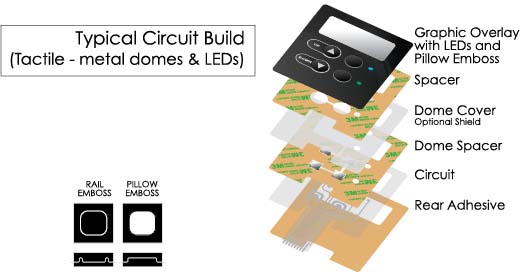Explore the Benefits of Using a Membrane Switch in Modern Devices
Explore the Benefits of Using a Membrane Switch in Modern Devices
Blog Article
Comprehending Membrane Layer Switches: The Key to Durable and Reliable Controls

What Are Membrane Layer Buttons?
Membrane buttons are an advanced remedy in the realm of interface technology, combining capability and style flawlessly. These gadgets work as an interface in between individuals and electronic systems, integrating a number of elements into a compact format. Commonly built from flexible, slim layers of products, membrane buttons are made to reply to touch, enabling customers to interact with equipment and electronic tools effectively.
The primary components of a membrane layer button consist of a published circuit layer, visuals overlay, and a spacer layer that stops unintentional activation. The visuals overlay can be customized to reflect brand name identification or individual preferences, enhancing visual appeals while guaranteeing usability. Membrane buttons are typically used in numerous applications, including clinical gadgets, consumer electronics, and commercial tools, owing to their toughness and resistance to ecological variables such as wetness and dirt.
Among the essential advantages of membrane layer switches is their ability to hold up against damage, making them ideal for high-traffic environments. In addition, they are light-weight and require marginal room, permitting for ingenious styles in product advancement. In general, membrane changes represent a practical and reliable choice for modern-day digital user interfaces, weding innovation with user-centric style principles.
Exactly How Membrane Switches Over Work
The operation of membrane switches joints on a basic yet efficient system that translates customer input into digital signals. When a user presses the button, the top layer deforms, permitting a conductive element in the circuit layer to make contact with an equivalent conductive pad on the bottom of the visuals overlay.
The style of membrane switches can differ, however they usually integrate domes or tactile components to give comments to the customer, boosting the overall experience - membrane switch. The products utilized in membrane switches, such as polyester or polycarbonate, add to their longevity and resistance to ecological variables, consisting of moisture and dust. The printed circuits are commonly encapsulated, which shields them from wear and tear over time.
Benefits of Membrane Switches

Additionally, membrane buttons are known for their resilience. Built from robust products, they are resistant to dust, wetness, and physical wear, which significantly expands their life expectancy contrasted to typical mechanical buttons. This sturdiness makes them specifically suitable for high-traffic environments and applications requiring durability.
An additional substantial advantage is the simplicity of cleansing and upkeep. The smooth surface area of membrane layer switches decreases dust buildup and is often unsusceptible spills, making them excellent for setups that call for frequent sanitization.
Moreover, membrane layer switches provide a streamlined account, bring about a thinner layout that can be incorporated into various tools without including bulk. This function not just improves the aesthetic allure yet likewise contributes to a much more ergonomic product design.
Applications of Membrane Layer Buttons
Flexible and easy to use, membrane switches discover applications throughout a vast array of markets, including medical tools, consumer electronic devices, and commercial tools. In the medical area, these switches are integral to devices such as analysis equipment, person tracking systems, and infusion pumps, where dependability and ease of cleaning are crucial. Their capacity to maintain and withstand harsh settings performance makes them excellent for such applications.

In consumer electronics, membrane layer buttons are utilized in items like microwaves, cleaning equipments, and remote controls - membrane switch. Their streamlined layout permits user-friendly interface, enhancing the why not try here total individual experience while offering resilience and resistance to deterioration
Commercial tools likewise benefits from membrane buttons, particularly in control panels for machinery and automation systems. These switches offer security versus dirt and dampness, ensuring regular performance in difficult settings. Furthermore, their customizable attributes allow suppliers to tailor them to specific functional needs, enhancing effectiveness and performance.
Selecting the Right Membrane Layer Switch Over
When selecting a membrane layer switch, it is crucial to take into consideration numerous factors that affect performance and viability for certain applications. The primary considerations include ecological problems, responsive feedback, durability, and layout specifications.
First, assess the operating atmosphere; buttons subjected to wetness, chemicals, or severe temperatures require specific materials to guarantee long life and performance. Next, assess the need for tactile responses. Depending upon user communication, some applications might take advantage of a responsive feedback to confirm activation, while others may favor a non-tactile style for visual reasons.
Durability is one more critical factor; membrane switches ought to be developed to withstand frequent usage, impacts, and abrasion. Make certain the chosen switch can endure the expected lifecycle, especially in high-usage situations.

Verdict
Finally, membrane switches act as vital components in the style of trustworthy and this website durable control systems throughout various industries. Their compact style, integrated with robust construction and adjustable attributes, enhances user interaction while making sure longevity popular settings. The versatility of membrane switches over enables tailored options that satisfy specific operational needs, reinforcing their importance in contemporary technology. As industries continue to evolve, the significance of integrating reliable membrane switch remedies can not be overstated.
Membrane changes represent an essential element of contemporary user interface style, blending performance with strength in numerous applications.Membrane buttons are a more information sophisticated remedy in the realm of customer interface technology, combining functionality and design seamlessly. Usually created from versatile, thin layers of materials, membrane layer buttons are developed to respond to touch, allowing individuals to engage with equipment and digital devices efficiently.
The layout of membrane layer switches can differ, but they usually integrate domes or tactile components to supply feedback to the user, enhancing the general experience.In conclusion, membrane changes serve as important parts in the design of durable and trustworthy control systems throughout numerous markets.
Report this page